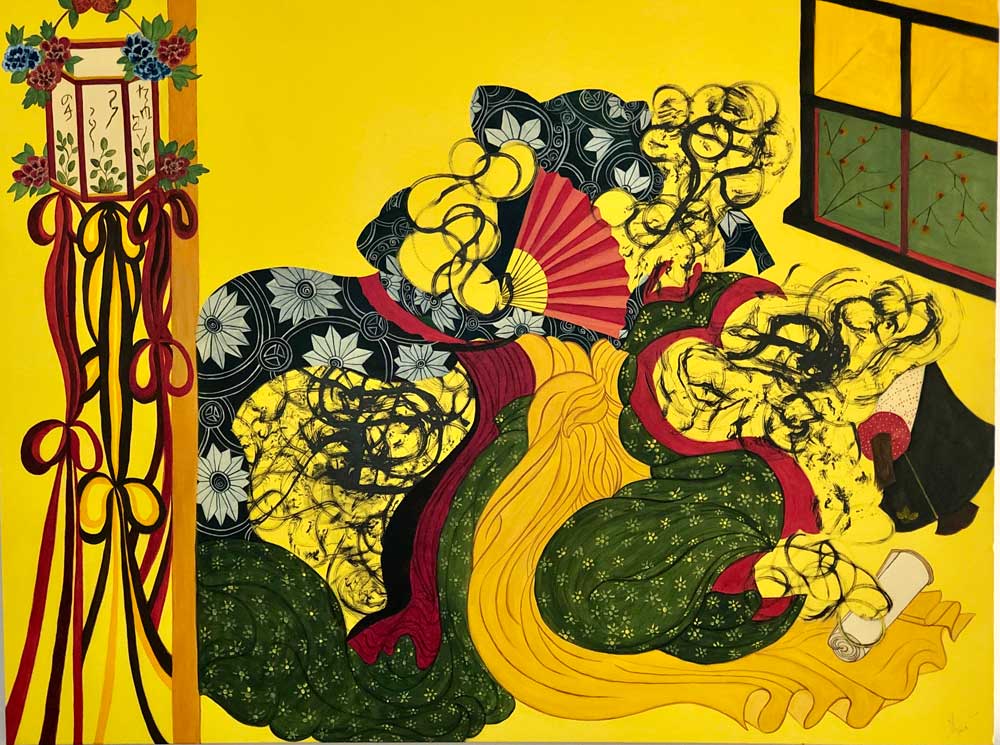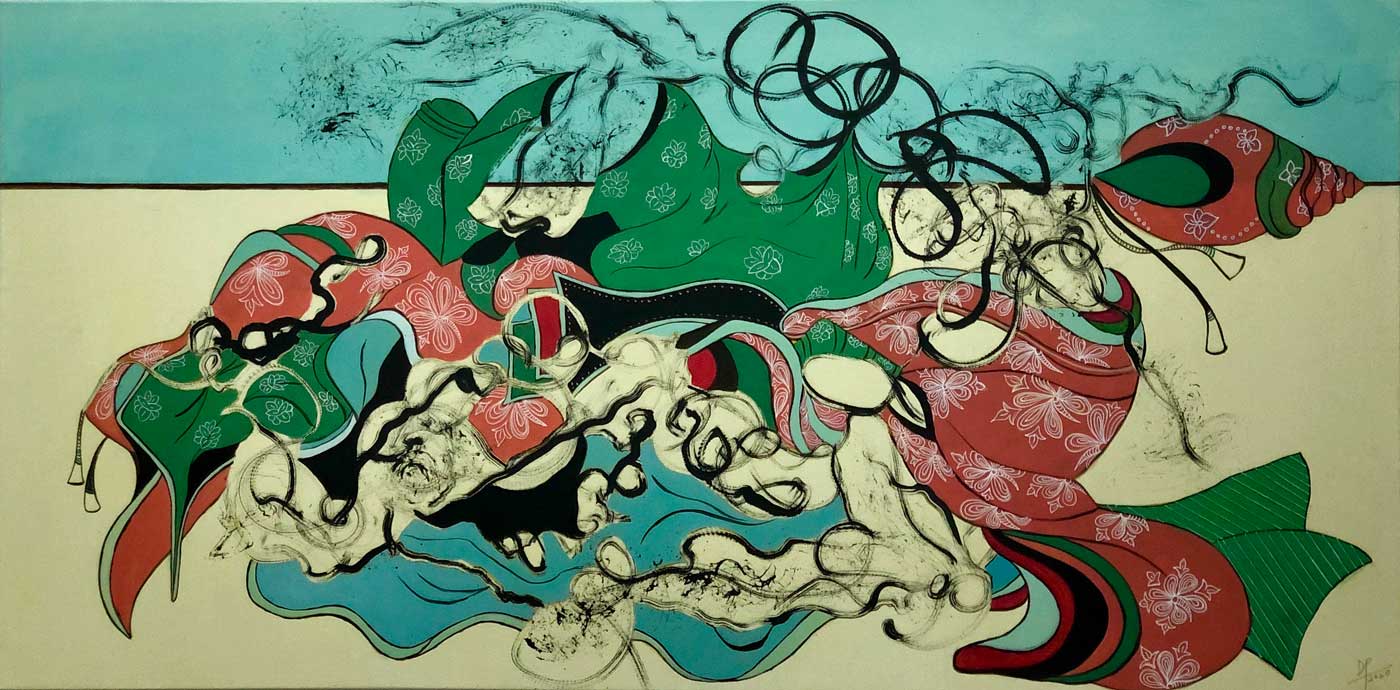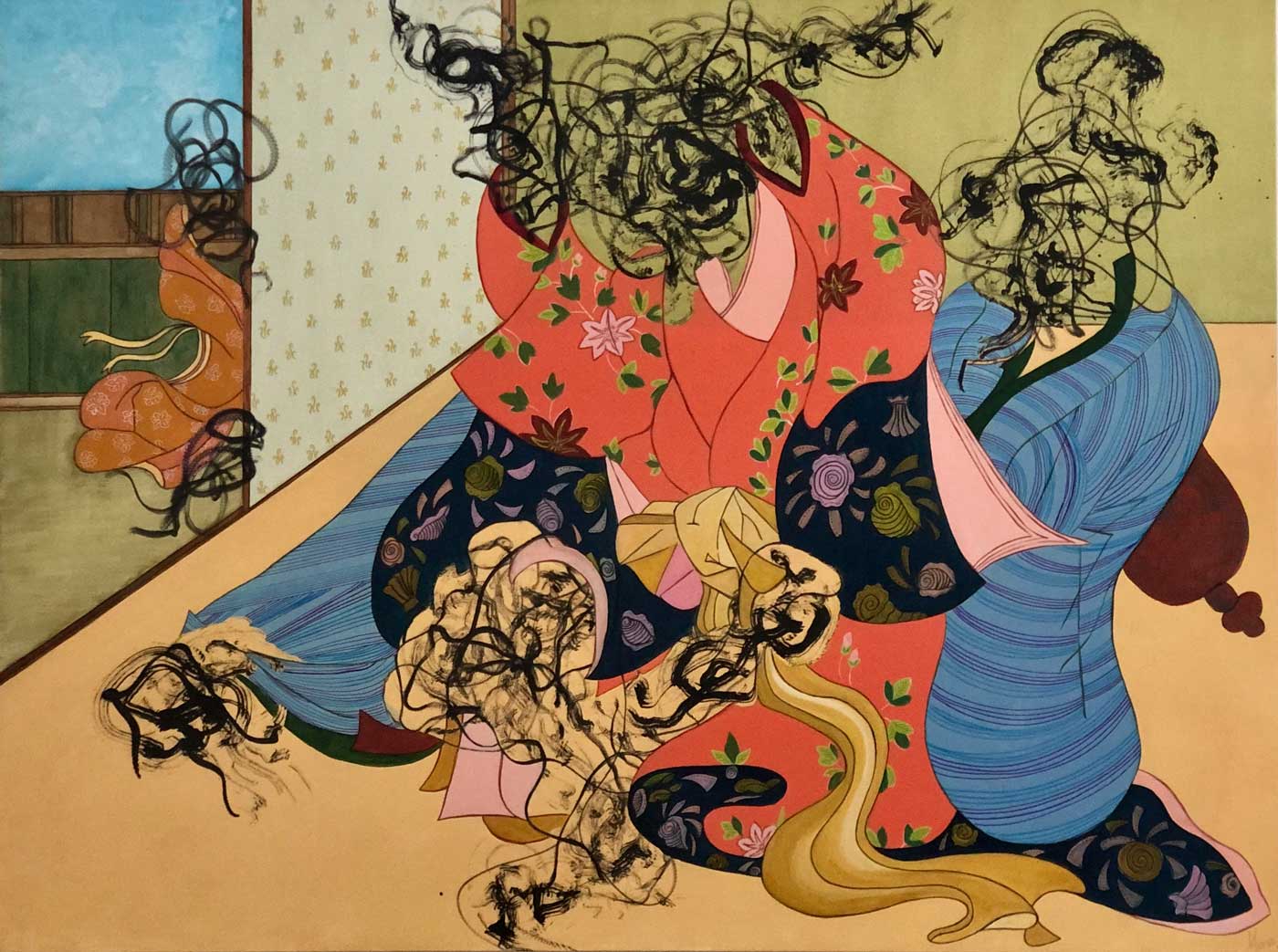‘Desire Lines and Pages From the Book of Spring’ explores contemporary perceptions of female sexuality and female sexual pleasures. ‘Desire lines’ is an architectural term, usually used to describe trampled paths that deviate from the pre-planned urban design. Similar to urban planning, in the context of female sexuality, desire lines can be considered as solutions that ingeniously navigate the terrain of social, political and religious norms and subvert perceptions of female sexual pleasure.
In my work, I employ a combination of artistic interventions, and performative drawing processes. I assemblage with electro mechanical devices associated with sex, infamously known as sex toys to create drawings reminiscent to action paintings. Action paintings were known to express the subconscious. Here, the subconscious is that of the assemblage – the gadget and the artist’s body and the marks on the surface, an impression of desires arising, not from a lack but in a hope of creating new interventions (Gilles Deleuze 154-157). These alien looking marks with machine like imprints, disintegrate heteronormal binaries and challenge the historical materiality of the sexual device. Chance is an integral part of this work and I associate this chance to the partial identities of women. As beings in a contemporary world, it is all about experimenting with new found desires, always recreating and regenerating, always becoming but never arriving. The drawings carry notions of bastardization – a monstrosity of not conferring to set boundaries but overcrossing, rejoicing in this illegitimate fusion of human and machine (Haraway 176). A process of ‘becoming’ with no particular end (Gilles Deleuze 162).
“Only by being out of place could we take intense pleasure in machines, and then with excuses that this was an organic activity after all, appropriate to females” – Donna Haraway.
‘Pages from the Book of Spring’ is a version of ‘Desire Lines’ in which I fuse the abstract vibrator drawings with historical erotica, especially the Japanese Shunga from the Edo and Meiji Period in Japan. The Shunga mainly depicted heterosexual relationships and the lives of the emerging middle class during the 17th -19th century. The ancient collection of books, scrolls and prints were filled with middle class male fantasies that acted not only as an escape from the dreariness of everyday life but also succeeded in eroticizing and normalizing the act of sex. In my drawings, I explore different aspects of this early eastern pornography and re-interpret the images through a feminine assemblage of body and machine. I incorporate these far off cultures into my work as I find the learning stimulating. I call them ‘half learnings’ which allow me to decipher what I know from my own culture and what I acquire from a learnt experience.
Whilst retaining some of its historical aesthetics, I push the boundaries by using unconventional tools, mediums and half abstract forms. The black ink vibrator marks representing female sexual desire and the body, are created with the help of household implements – kitchen scrubbers, brushes and sponge cleaners. These everyday tools signify but at the same time reject feminine ideologies of domestication and the private in an unconventional manner. The physical body in this work does not have its usual form or structure, eliminating its sexual signifiers and challenging notions of the male gaze. Also the female objectifiers are metamorphed into a female / artist, female/assemblage binary purging its usual signifiers.
Through these absurd re-interpretations, I deconstruct historical ideas of eroticism, objectification and sensuality that are the foundations of the act of sex that ultimately subjugate female sexuality. My art breaks these societal norms of female pleasure and reclaims a space for female desires by way of the assemblaging cyborg and regenerates history from an alternative stand point.

Title: Erotic readings of my mind
Size: 49 x 35 cm
Medium: sequence, gouache, and black ink on acid free Fabriano paper
Year: 2022

Title: Under the Kotatsu
Size: 76 x 56 cm
Medium: collage on Bockingford paper – velevet tape, acrylic ink vibrator marks, acrylic paint, graphite pencil
Year: 2022

Title: But for love darling, look elsewhere
Size: 60 x 46 cm
Medium: collage, acrylic ink vibrator marks on canvas
Year: 2022

Title: Oh, the things I wish to do to you
Size: 49 x 35 cm
Medium: fabric tape, gouache, and black ink on acid free Fabriano paper
Year: 2022

Title: Lovers and A Lantern
Size: 120 x 91 cm
Medium: acrylic on canvas
Year: 2021

Title: PleasurePort
Size: 8.5 x 8.0 x 5.5 cm
Medium: assemblage Sculpture, kitchen scrubber, toothbrush holder, sex toy
Year: 2021

Title: Behind the Byobu (Akoyikust IEttes)
Size: 122 x 61 cm
Medium: acrylic on concrete ceiling board
Year: 2020

Title: Splayed (Akoikust)
Size: 61 x 122cm (without frame)
Medium: acrylic on concrete ceiling board
Year: 2020

Title: Floating (Ubonoyot)
Size: 120 x 60cm (without frame)
Medium: acrylic on canvas
Year: 2020

Title: What did you see? (Awagayim Nuhsoch)
Size: 120 x 91cm (without frame)
Medium: acrylic on canvas
Year: 2020

Title: Green Rinpa
Size: 75 x 60cm (without frame)
Medium: acrylic on canvas
Year: 2020

Title: Crimson Lining
Size: 75 x 60cm (without frame)
Medium: acrylic on canvas
Year: 2020

Title: On The Balcony (Iasukoh)
Size: 61 x 60cm (without frame)
Medium: acrylic on concrete ceiling board
Year: 2020

Title: A thin mattress (Ubonoyot)
Size: 42 x 30cm (without frame)
Medium: coloured pastel paper, Gouache, vibrator marks
Year: 2019

Title: Untitled (this was the first piece i created in this series)
Size: 42 x 30cm (without frame)
Medium: Coloured Pastel Paper, Acrylic Paints, Vibrator Marks
Year: 2019

Title: Untitled
Size: 68 x 46cm (without frame)
Medium: water colour on Fabriano paper
Year: 2019

Title: Clumsy (Ohcnus)
Size: 46 x 69cm (without frame)
Medium: gouache on Chinese rice paper
Year: 2019

Title: Quick encounters (Awakishi)
Size: 59.5 x 21.5cm (without frame)
Surface: Concrete ceiling board
Medium: water colour, origami paper, vibrator marks
Year: 2019


